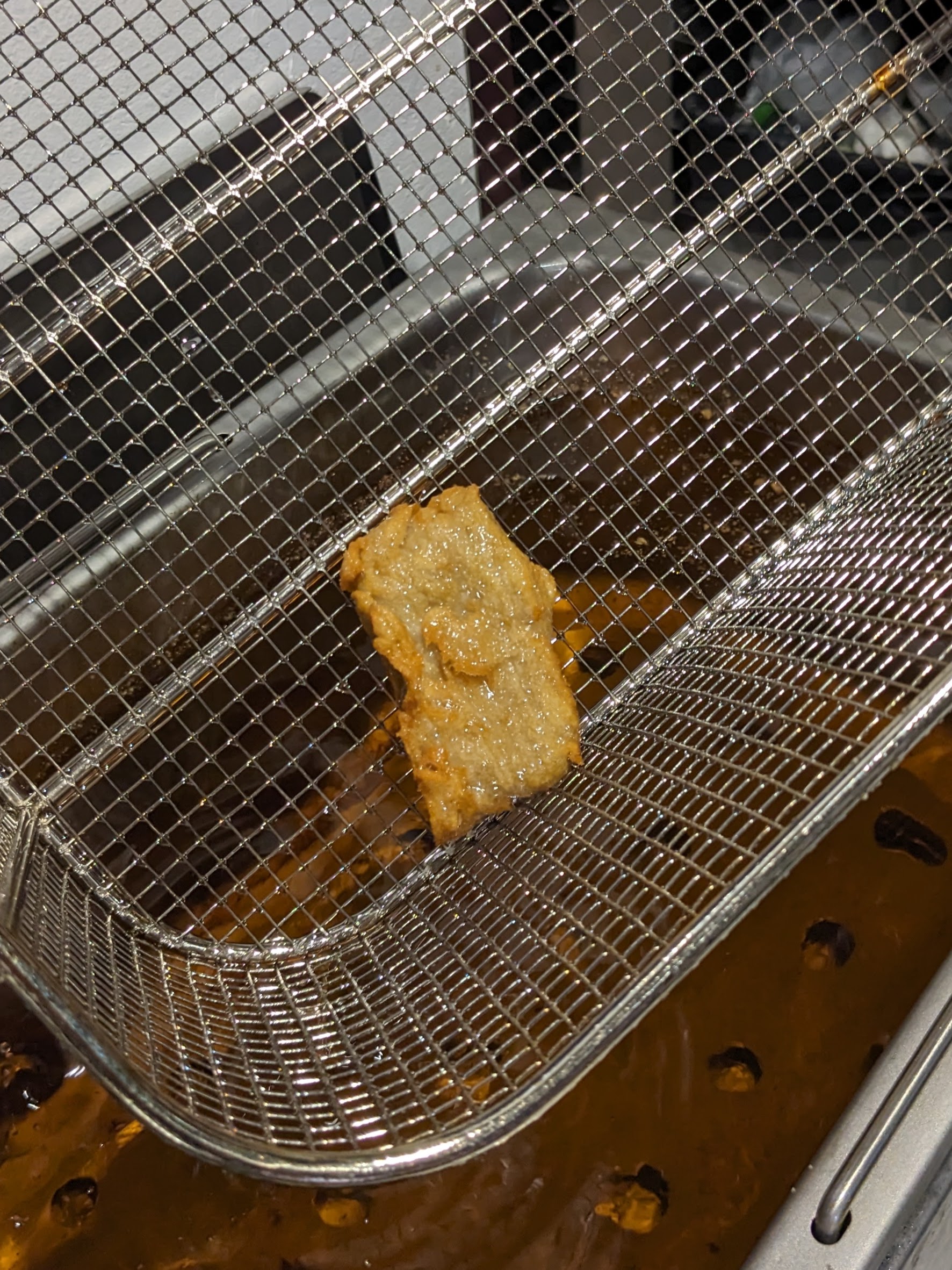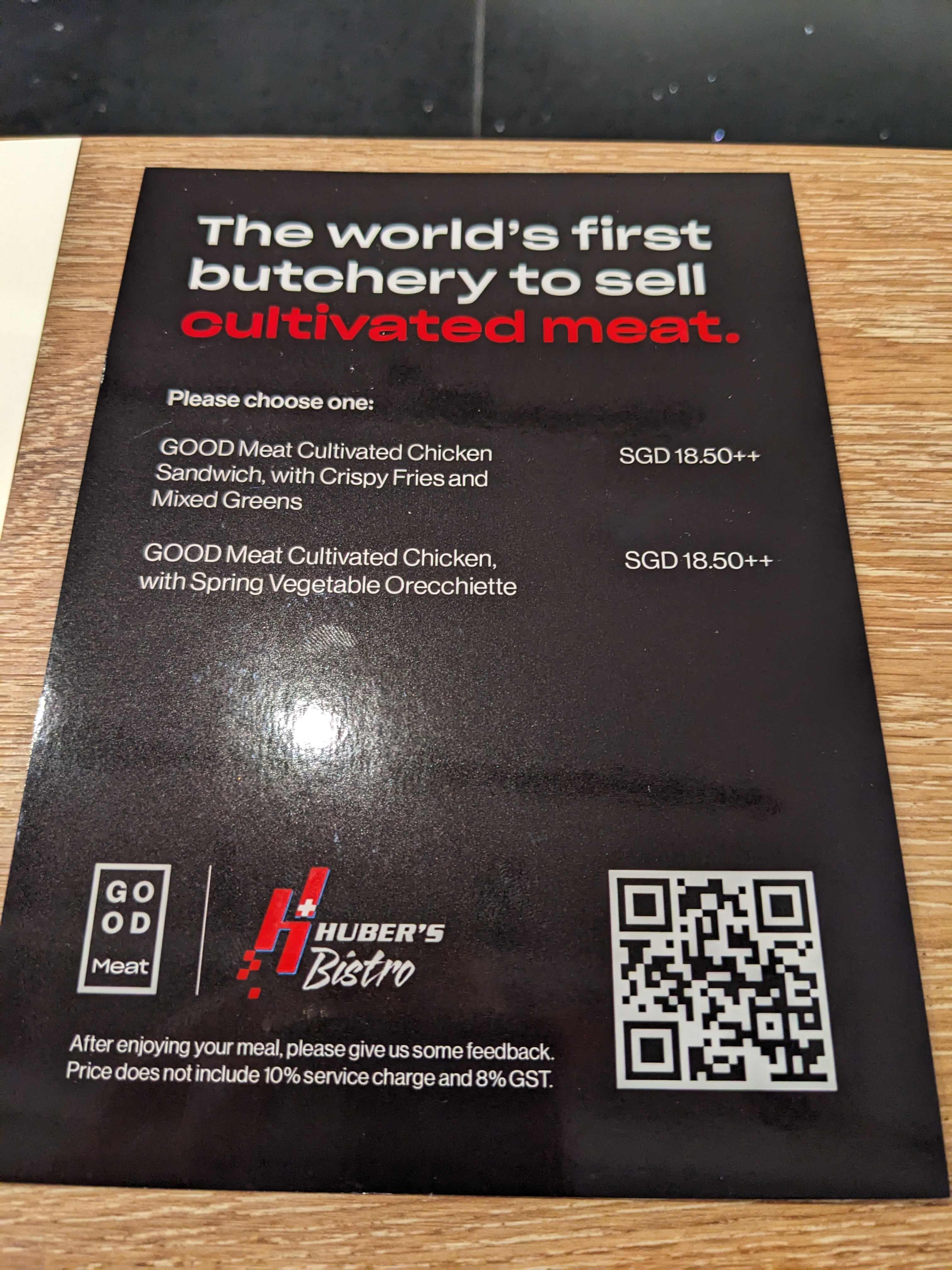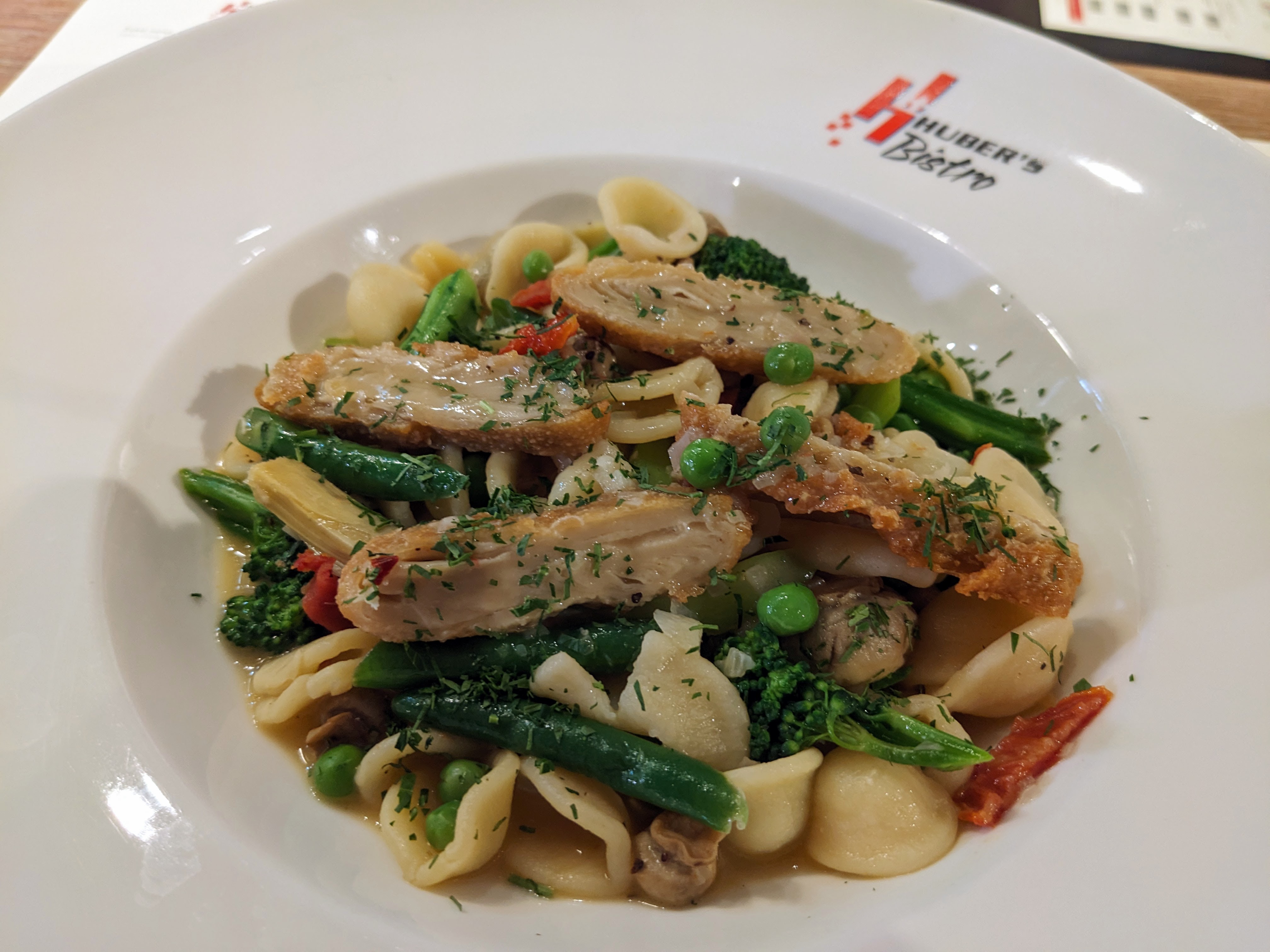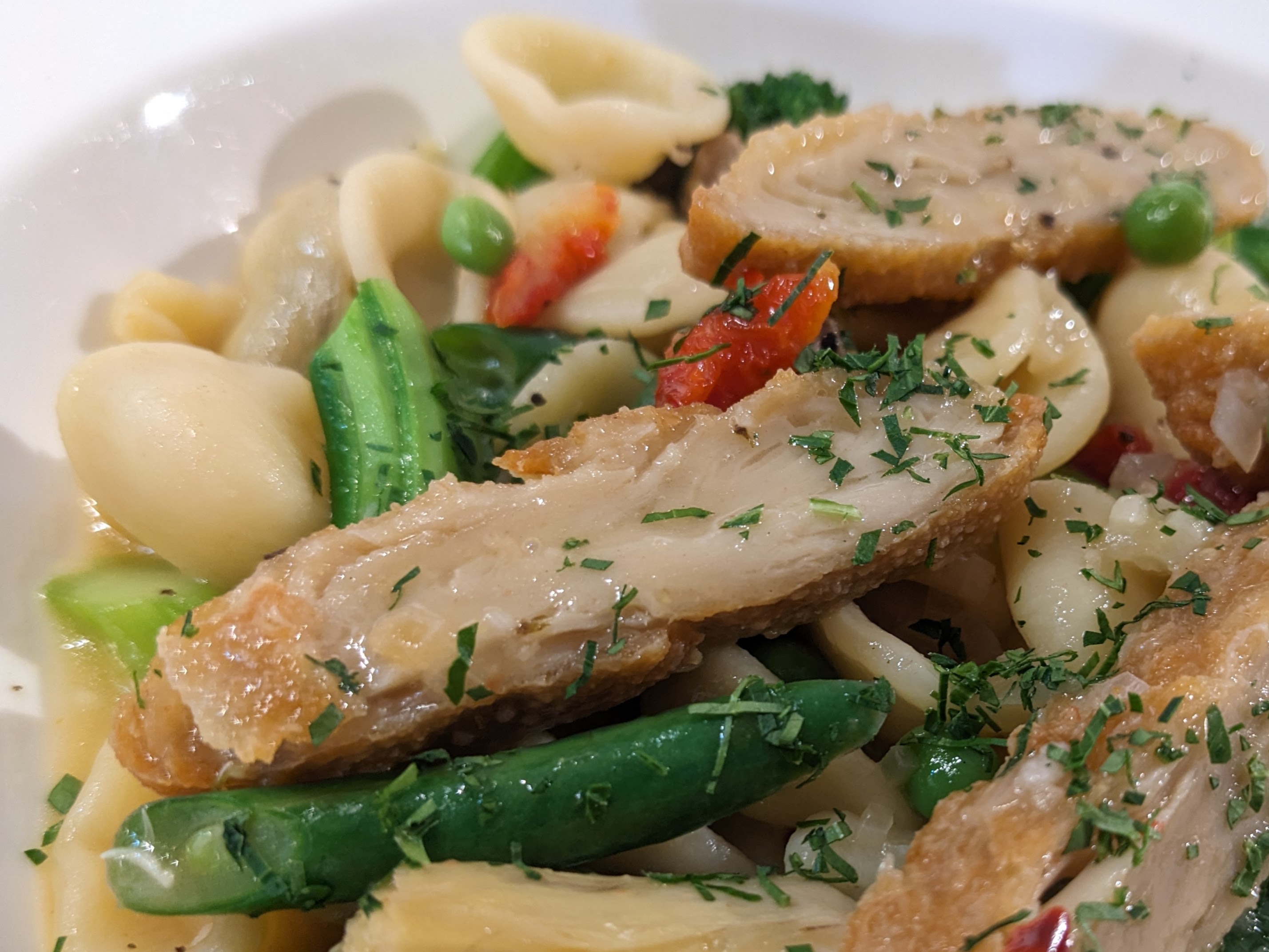Singapore is the only country in the world where it’s legal to sell “cultivated” (lab-grown) meat for human consumption, and Huber’s Bistro in Singapore is the only restaurant in the world that actually sells the stuff. But you can’t just waltz in and try it: only on Thursdays are there 12 portions up for grabs at lunchtime, and to score one, you need to snap it up when bookings open the previous Sunday at 11 AM Singapore time. I was back in Singapore this week for a conference, so I tried my luck and, much to my amazement, managed to snag a seats. Here’s how it went.


Huber’s Butchery is a bit of a local institution, well known for its Swiss branding and extensive range of high-quality and/or exotic meat: if you’re hankering for some premium quails or would like to pay $170/kg for wagyu beef, you’re in the right place, and like half the expat community we used to get our Christmas turkeys here. Their in-house bistro usually serves up Swiss fare like rösti and sausages, but as I type this it’s closed for renovation and the lab chicken action is upstairs in the little demonstration kitchen, with sushi bar style seating for around 6 people. When I rocked up for my meal, there was an Italian TV crew busily interviewing a spokesman and two clipboard-toting grad students hovering nearby to survey diners.
The chicken sold here comes from GOOD Meat, a new brand for San Francisco based company Eat Just, which is backed by $475 million in venture capital and already sells plant-based eggs in the US. GOOD Meat Cultivated Chicken™ is made by taking cells of actual chicken meat, growing them in a bioreactor for 4-6 weeks, and then harvesting the end result: their website’s Process page goes into some detail, and apparently it’s bootstrapped enough that the current culture no longer needs any cells from live chickens in the mix. The end result is, apparently, a millimeter-thin layer of meat that’s then wrapped around itself to form a small shark’s-fin shaped cutlet about the size of a child’s palm. I was briefly shown the raw end product, still wrapped in thick plastic like the lab sample it is, but no photos were allowed until it came out of the deep fryer, golden, puffed up and looking like a slightly oversized rectangular chicken nugget.


There are two options on the menu, namely a crispy chicken sandwich with fries and spring vegetable pasta topped with chicken, both of which contain the same deep-fried cutlet. (The grilled chicken kebab “brochettes” shown in earlier publicity photos are no longer available.) I picked the pasta because I figured it would let me taste a ‘purer’ chicken, but after deep-frying, my cutlet was sliced into four and cooked once more in the pasta sauce. One of the “spring vegetables” turned out to be canned artichokes, whose strong, vinegary taste dominated the entire dish, and as a final layer of camouflage the assembled dish was topped up with a spray of chiffonaded parsley.
Finally, the moment of truth. The dish was served up and I gingerly poked at my Frankenchicken with fork and spoon. No knife was provided, and I suspect this was intentional, so diners don’t dissect their samples on their own; fork & spoon is a common combo in SE Asia, but not for Western food.


The surface of the meat was an odd shade of beige, neither white nor dark meat but some mathematical average of the two, and it looked slick and slippery, more like a slice of cooked mushroom than a cut of chicken. The striated texture of the layers, resembling the rubbery Chinese “vegetarian chicken” (素鸡) made from tofu skin, was clearly visible. In short, this did not look hugely appetizing.
Biting into it, though, the texture was surprisingly chewy and meaty, and it really did taste like chicken, that bland-yet-umami flavor you get from homemade chicken stock – although replaying the scene in my head, it’s hard to tell what part of the taste came from the chicken and what part of it came from the garlicky stock, the artichoke juice, the oil it was deep fried in, etc. At the same time, when compared to an actual piece of chicken meat with muscle fibers, the texture was quite clearly “wrong”. As it stands, this product would not pass muster even as a McDonald’s chicken nugget.
But is it chicken? Yes, clearly, this was a world apart from any tofu or gluten mock chicken product I’ve tried, or fellow Singaporean startup Tindle’s plant-based chicken. If you were to use this as a substitute for mechanically separated chicken meat (“white slime”) for heavily processed chicken products like deli counter chicken breast slices or the filling of chicken bao buns, I’m pretty sure most people wouldn’t even notice, particularly if mixed with other ingredients. The problem for the company is that this is also the absolute bottom of the barrel in the chicken value chain, and that brings us to the challenging economics of scaling this up.
My meal today cost S$22 (~US$16), but realistically speaking I suspect this only just about recoups Huber’s costs and it’s difficult to tell anything about the actual cost. Doing the napkin math, if Eat Just’s current 1,200L bioreactor can produce 12 servings a week, 52 weeks a year, that’s a grand total of 600 nuggets a year. If they can capture the entire $22 per serving, that’s around $10,000, but at the regular nugget market price of 64 cents a piece, it’s less than $500. Eat Just is scaling their Singapore operation up to 2 x 6,000L next year, but a 10x increase is a drop in the bucket and still a long, long way for their much-publicized plans for 10 x 250,000L. If that 100L/serving/week ratio holds, even that would only be 25,000 nuggets, in a world where Americans alone go through 44 million a week. Eat Just’s own claim is that they can produce 13 tons a year, which at 10g per nugget divided by 52 weeks lines up with my napkin math perfectly: exactly 25,000 per week. And this assumes they can scale up the bioreactors, which is well known to be very, very hard.
In this light, the carefully stage-managed restaurant experience makes sense: the goal here is not to sell lab-grown chicken, but to pitch it as an Instagrammable experience that’s the vanguard of a new, ethical way to have your meat and eat it too, and drum up more venture capital to keep the bioreactors going. I wish Eat Just the best of luck, but barring massive breakthroughs in the technology, we’re still decades away from lab-grown steaks jostling for space with the actual-cow wagyu downstairs at Huber’s meat counters.